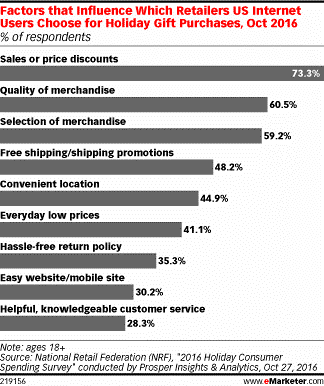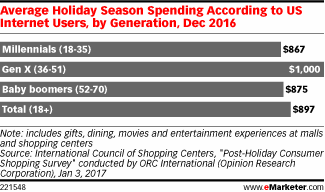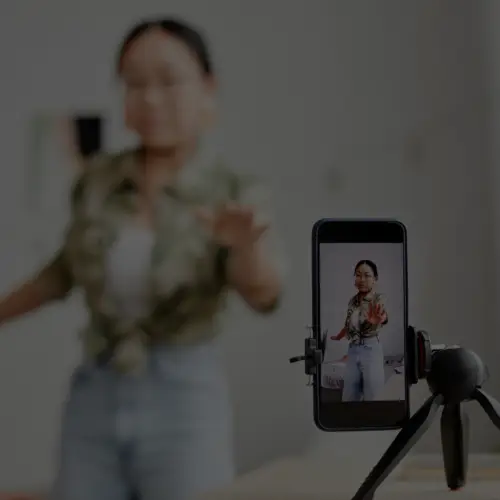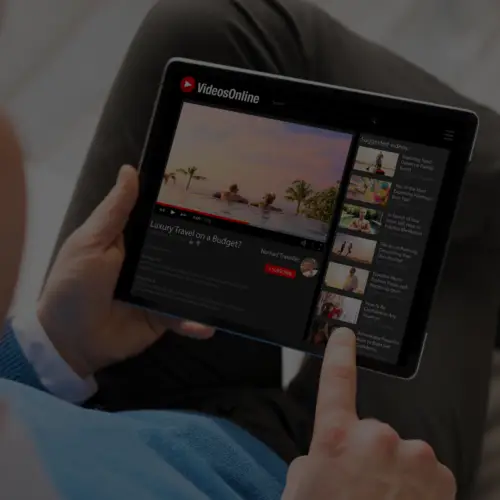
25 Jan 2016 Holiday Social Ad Spend; What We’ve Learned
Typically, the last quarter of the year brings some of the highest media costs of the year; especially around the holidays. The final months of 2016 brought about a surprise to us as we saw costs relatively flat on the social front. This includes spend using the native buying platforms on Facebook, Pinterest, Twitter and Instagram. We will add that, when possible, we’ve side-stepped spending media dollars around the holidays and reserved those dollars for more efficient quarters (such as first and third).
This past year we didn’t see the spikes we typically encounter. That’s great news for our clients spending money as their dollars stretched further than anticipated and fell more in line with that of all 2016. That said, retails sales for the holiday season didn’t hurt as they were up 4% over 2015 to $658.3 billion. That includes $122.9 billion in non-store sales which experienced a 12.6% increase from the year prior. What factors influenced gift purchase decisions? The majority (73.3%) of US Internet users specified sales or price discounts followed by quality of merchandise (60.5%). What factors did not score as high but still influenced users? Easy website/mobile sites (30.2%) and helpful, knowledgeable customer service (28.3%). Which age demographic had the highest average overall season spend? Gen X at about $1K.


What are the key takeaways? Sales, particularly online, had a strong uptick over the holidays and paid social spend was extremely efficient making it a lucrative means to secure more online dollars. We can’t predict if next year’s costs will be so generous to advertisers but here are a few ways to ensure the best spend to convert to sales:
- Test your messages. It’s clear from the 2016 data that different influences impact purchasers differently. For instance, sales price and discounts had a strong influence as did quality and selection. Test different incentives in your creative to see how each performs and then adjust your spend accordingly. Of course, we also strongly encourage testing copy and imagery. What we often find though is that simple works best. If you want to drive an action, make it clear, make is resonate and make it easy to do.
- Optimize your audiences. Whether you use standard demographics, interests, behaviors, retargeting, competitors or custom data to target, be sure that you are segmenting these audiences distinctly so you can monitor the differences in their respective performance. For instance, if you separate by age group, you can see which one has a larger cart size and change your approach to maximize sales. As another example, you can also test interests against retargeting and see which one has a lower CPM and adjust your spend from that perspective.
- Track conversions. One of the beauties of many social networks is the ability to track conversions to see which creative resonates best and with whom. When conversion tracking is in place, you can see which elements result in the best ROI. Be sure that not only time is built to develop amazing creative and place it, but also be certain to include time to optimize so that dollars are spent most efficiently. When we buy media, this is always worked into our approach and we consistently beat out industry averages as we whittle away at a buy until we land at the optimal spend.
This past holiday was a win for social media advertisers. We can hope but can’t count on the same results in 2017, but one thing we do know is that social media ad spend is on the rise and with this we can’t expect a decrease in costs; it’s just too competitive. So be sure and plan ahead for 2017, including staying clear from traditionally high cost periods, stay tuned into all the channels for new offerings that may suit your business well, and always, always optimize your media spend.






